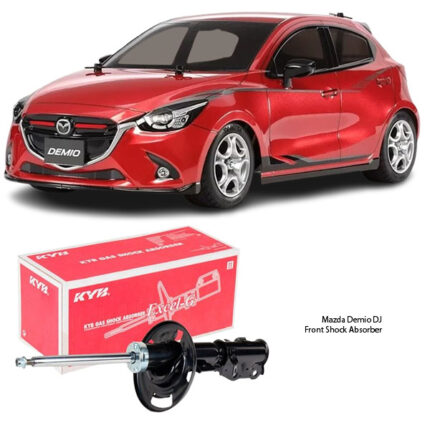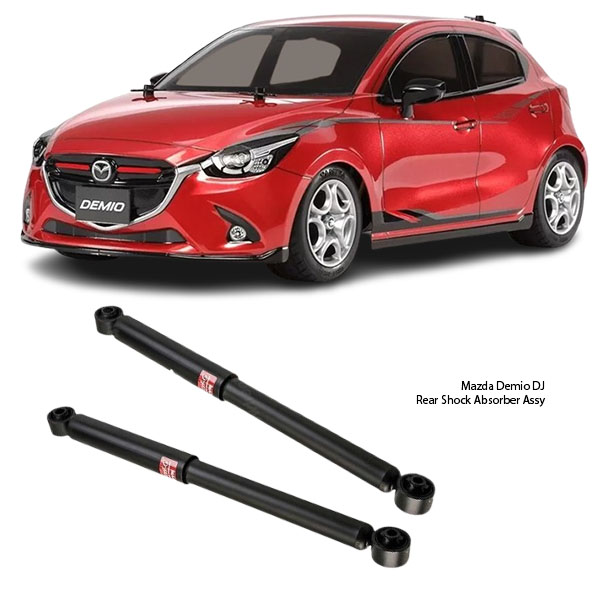-7%
Get Mazda Demio DJ / DL Rear Shock Absorber Assy 3430045 in Kenya
When you’re cruising down the road and hit a bump, pothole, or dip, what keeps your car stable, your tires planted, and your ride smooth? It’s the shock absorber — or more precisely, the rear shock absorber assembly — quietly doing its job behind the scenes. 🔧💨
Despite being one of the most critical components in your suspension system, shock absorbers are often overlooked… until they start to fail. The rear shock absorber assembly isn’t just about comfort — it’s about safety, handling, stability, and control. Whether you’re driving through city streets or taking on rough terrain, these unsung heroes work non-stop to give you a balanced and composed ride. 🛤️🌟
🔧 What Is a Rear Shock Absorber Assembly?
The rear shock absorber assembly is a suspension component located at the back of the vehicle. It typically includes:
-
The shock absorber (damper) itself
-
Mounting hardware or brackets
-
Bushings or rubber mounts
-
In some cases, it includes a coil spring (in a coil-over setup)
This assembly connects the rear axle or suspension arm to the vehicle chassis, absorbing and dissipating the energy from road irregularities. Without it, your car would bounce uncontrollably after every bump, making driving dangerous and uncomfortable. 🚧⚠️
💡 How Does It Work?
When your car moves, it interacts with the road surface — hitting bumps, dips, potholes, and more. The rear shock absorber assembly plays a key role in:
-
Controlling suspension movement during bumps and rebounds 🔁
-
Reducing oscillation (that bouncy feeling after a dip) 🎢
-
Keeping your tires in contact with the road for traction 🚘🛞
-
Preventing excess body roll during turns or lane changes 🌀
-
Providing a smooth and stable ride for passengers 🛋️
Inside the shock absorber is a piston that moves through oil or gas. As the suspension compresses and rebounds, this movement is dampened by hydraulic resistance — converting kinetic energy into heat and absorbing the shock. 🔥🛠️
✅ Key Benefits of a Good Rear Shock Absorber Assembly
1. Ride Comfort
The most noticeable benefit is a smoother ride. Good shocks absorb harshness from potholes and speed bumps, making driving more enjoyable. 🌈
2. Handling & Stability
Shock absorbers keep your car balanced and composed during acceleration, braking, and cornering — especially at high speeds or during emergency maneuvers. ⚖️🚦
3. Tire Contact & Safety
Shocks help maintain maximum tire contact with the road. This is crucial for grip, braking, and control in wet, dry, or uneven road conditions. 🛞🛑
4. Reduced Wear on Other Parts
With a functioning shock absorber assembly, other components like tires, bushings, and suspension arms are under less stress — extending their lifespan. 📆🔩
5. Control Under Load
Whether you’re carrying passengers or cargo, rear shocks ensure your vehicle handles well and stays level — even when loaded. 📦👨👩👧👦
🔍 Signs of a Worn Rear Shock Absorber
Shock absorbers wear gradually over time. Here are clear warning signs to watch out for:
-
🚫 Excessive bouncing after bumps
-
🚘 Swerving or nose-diving when braking
-
🌀 Body roll or unstable handling during cornering
-
💧 Oil leakage from the shock body
-
🔈 Clunking or knocking sounds from the rear
-
🛞 Uneven or rapid tire wear
If your rear shock absorbers are worn out, you’re not just losing comfort — you’re compromising safety. Don’t wait for a breakdown — inspect and replace as needed. 🔍⚠️
🧪 Types of Rear Shock Absorbers
There are several types of rear shocks used in modern vehicles:
1. Twin-Tube Shock Absorber
Most common in standard vehicles. They provide a good balance of comfort and performance. 🛠️
2. Mono-Tube Shock Absorber
Offers better cooling and performance. Common in sports cars and high-performance vehicles. 🏁🔥
3. Gas-Charged Shock Absorber
Includes nitrogen gas to reduce foaming and improve damping efficiency. Great for off-road or heavy-duty use. 🌄💪
4. Coilover Shock Assembly
Combines a spring and shock absorber in one unit. Adjustable versions are popular in racing and tuning. 🏎️🧰
🛠️ Installation Tips
Replacing rear shock absorbers is usually straightforward, but always follow manufacturer specifications and safety procedures.
-
Safely lift and support the vehicle 🧯
-
Remove old shock absorbers and inspect mounts and bushings 🔍
-
Install the new assembly, torquing bolts to spec 🔩
-
Check alignment and test-drive the vehicle to ensure smooth performance 🚗✅
It’s always a good idea to replace shocks in pairs (left and right) to maintain balance and performance.
🔄 Maintenance & Lifespan
Rear shock absorbers generally last 60,000 to 100,000 km, but lifespan varies depending on:
-
Driving conditions 🛣️🪨
-
Vehicle weight and load 📦
-
Quality of the roads 🌧️
-
Type and quality of the shocks themselves
Routine inspection every 10,000–20,000 km is recommended. Keeping them clean and free of road debris helps extend their life.
🔧 OEM vs. Aftermarket: Which Should You Choose?
-
OEM (Original Equipment Manufacturer) shocks match factory performance and are ideal for daily drivers seeking comfort and reliability. 🧩
-
Aftermarket performance shocks offer firmer damping, adjustability, and better road feedback for spirited driving, off-roading, or custom builds. 🛞💨
Choosing the right shock depends on your goals — comfort, load-carrying, sportiness, or durability.
🌍 Real-World Applications
From small sedans to SUVs and pickups, rear shock absorber assemblies are essential in:
-
Daily commuting 🚙
-
Long-distance travel 🛣️
-
Load-hauling 🏋️♂️
-
Off-road adventures 🌄
-
Towing trailers 🚛
Whether you’re gliding through Nairobi city traffic or exploring rough country roads, a solid rear shock setup ensures you stay safe, comfortable, and in control. 🛤️🔒
🏁 Final Thoughts
A smooth ride, confident handling, and safety in every corner — the rear shock absorber assembly is a vital piece of the puzzle. It doesn’t just dampen bumps; it anchors your vehicle’s suspension, ensuring control, balance, and long-term durability. 💪
Ignoring worn shock absorbers can lead to more than just discomfort — it can increase stopping distance, reduce grip, and put unnecessary stress on your vehicle.
So if your rear end feels bouncy, floaty, or noisy — it’s time to pay attention. Replace worn shocks, restore your ride, and rediscover the joy of confident driving.
Follow us on Facebook for more parts.



